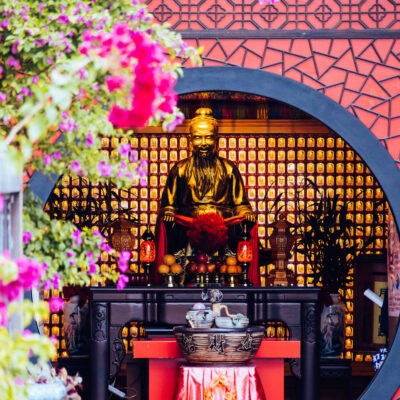Women’s rights and women’s perspectives are still often overlooked in terms of national security, international affairs and conflict between states.
This is despite a great deal of work by academics, civil society and others showing that women play a hugely important role in the prevention of conflict and peace-building.
It’s also despite decades of effort by some to focus attention on the gendered impacts of conflict, the particular needs of women in conflict-affected areas and their exclusion from peace processes.
Natasha Stott Despoja AO is a well-known advocate for gender equality and the elimination of violence against women in Australia and beyond. She is the founding Chair of Our Watch, the national Australian foundation to prevent violence against women and children; and since 2021 she has been a member of the United Nations’ Committee on the Elimination of Discrimination against Women (CEDAW).
Ms Stott Despoja spoke with Melbourne Asia Review’s managing editor, Cathy Harper.
China and the Unites States are competing for primacy in just about every domain, militarily, economically, technologically and in many other ways. This competition is perhaps felt particularly sharply in Asia. What issues do you think are being overlooked in the debate and analysis about great power competition?
What we often overlook is the impact of geopolitical competition on the day-to-day lives of civilians and women in particular. Trade wars, increased tariffs and economic sanctions are all measures that have an immense trickle-down effect on workers at the bottom of the supply chain and their families and communities. The devastating war crimes committed by Russia in Ukraine remind us in the most brutal way of the human cost of conflict. But while Russian elites have been individually targeted with sanctions following the Russian invasion, it is rarely the decision-makers that bear the brunt—usually those with the least power are the most impacted.
The US-China trade war, emerging predominantly during the era of former US President Donald Trump has impacted the US economy greatly, mainly due to US companies bearing the brunt of tariffs imposed on China. During this time, Moody’s Analytics estimated 300,000 US jobs and 0.3 percent of real GDP was lost, while a 2019 Bloomberg Economics report estimated the trade war had cost US $316 billion by late 2020. Analysis has found that American companies cut wages and jobs for US workers while simultaneously raising prices for consumers after their share prices fell.
Women are disproportionately impacted by great power competition particularly in terms of employment, pay and income, workplace discrimination and rights; especially if they are informal workers.
The Peterson Institute for International Economics found China’s rise and competition globally has put Chinese women at a disadvantage and has worsened gender inequality. It found that due to rapid economic growth to match the US, employers have been given more latitude to discriminate against women in the workplace through contracts in which female workers promised not to become pregnant or be fired without compensation. But interestingly, the report found this had actually created a drag on economic growth.
China’s Belt and Road initiative has had severe economic impact with critics believing it targets vulnerable economies within underdeveloped and developing countries such as Pakistan, Sri Lanka and Malaysia; and promotes ‘debt trapping’ diplomacy. According to Forbes, ‘the sheer scale of China’s lending and its lack of strong institutional mechanisms to protect the debt sustainability of borrowing countries poses clear risks’.
As the initiative grows in size and spending, it has been associated with the destruction of the environment, debt, and wasteful spending. Examples of tenuous projects include Hambantota Port in Sri Lanka and Malaysia’s East Coast Rail Link project/Melaka Gateway. There is not enough dialogue on how inefficiency, unfinished projects, corruption, job losses and crippling debt can devastate the most vulnerable in communities.
Women, children and marginalised groups are often left out of the public discussion that takes place amongst politicians, elites and academics. I can’t help but wish that the diversity and difference of the population was reflected in the commentary on these issues. I am particularly interested in the views of those without formal power. I think younger people provide us with some of the best insights and solutions.
Could a greater focus on women help prevent a military conflict between China and the United States?
One of my favourite statistics is that if women’s representation in parliament increases by five percent, that country is almost five times less likely to use military intervention to resolve international disputes.
Generally, we know that peacekeeping and negotiations on conflict are statistically more likely to fail and be less safe and secure when women are left out. It is well known and documented that increasing women’s participation in conflict prevention and peacekeeping initiatives decreases the chances of escalation and armed conflict. It is clear that there needs to be a long-term focus on increasing the role of women in peacekeeping and empowering the community to elect more female leaders.
In 2021, the Secretary General of the United Nations António Guterres warned of the worst increase in violence and crisis in generations if women are left out of peace negotiations. Similarly, the Executive Director of UN Women Sima Bahous has said that ‘investing in women’s economic empowerment yields great dividends for peace and prosperity.’
20 years ago, the UN Security Council adopted a specific resolution, Resolution 1325, on women, peace and security which calls on countries to address the impacts that conflict has on women and girls to systematically include women in peacebuilding efforts, including peace talks, peacekeeping and post-conflict reconstruction efforts. Can you speak a little about some of the successes in Asia in this space, and where perhaps where the issue is being overlooked?
In term of successes, the Thai government has worked with UN Women and others to promote the role of women in peace and security processes. A range of measures have been developed including the Sub‑Committee on Women, Peace and Security as the primary policy body on the UN’s ‘Women, Peace & Security’ agenda. The Committee includes representatives from key government agencies as well as civil society members and women’s advocacy groups. In 2016 the Thai government established and implemented the Measures and Guidelines on Women, Peace and Security (2017-2021) and held three national consultations to properly formulate the policy. These measures form a framework to empower women and facilitate their role in addressing conflict, and political and social unrest at national and international levels. Finally, the Thai government has worked with UN Women on the institutionalisation of the Coordination Centre for Children and Women in Southern Border Provinces that works to protect women and children from violence while increasing resilience in communities facing conflict.
Further, the Centre for UN Peacekeeping in collaboration with UN Women India has conducted almost 30 courses for UN peacekeepers on sexual and gender-based violence prevention. In Timor Leste, the UN Women Regional Office for Asia Pacific has helped implement the Women, Peace and Security agenda and develop their National Action Plan on the WPS agenda. Nepal has done a lot of work in this area too. Nepal’s Comprehensive Peace Agreement 2006 and its Peace and Development Strategy 2010 includes gender sensitive interventions for sustainable peacebuilding efforts. The Nepalese government has also endorsed a National Action Plan on WPS.
There are several areas of major concern. In Ukraine chilling examples are emerging of gender-based violence and the use of rape as a weapon by Russian forces. In Aceh and East Java in Indonesia, where there are high levels of conflict, not enough is being done to prevent sexual and gender-based violence or increase women’s participation in peacebuilding. Afghanistan is quite a heavily discussed topic, but in Pakistan women are also severely underrepresented in peacebuilding and overrepresented as victims of conflict, despite huge efforts to be at the forefront of activism and security talks.
China, as a permanent member of the Security Council supported Resolution 1325, as did the United States. But China hasn’t adopted a National Action Plan, as almost 100 nations have, including the United States and Australia. How significant do you think this is?
I think that this is a clear statement that this is not necessarily a national priority in China. But, as we know, supporting something at the UN is entirely different from dedicating the resources to implementing it on the ground.
China is not the only country guilty of treating the WPS Agenda as a branding exercise. In Australia, the reality is that WPS is not always well-integrated across the defence industry as well as across sub-national institutions and in state level governments.
The Australian government could scale up its commitment to the Women Peace and Security agenda in rhetoric as well as substance. We have done good work in this area, but it needs political goodwill in addition to resources. There have been concerns previously around the delay between consultations on updating the second National Plan, and its release, and the rate of change in women’s participation in the military as well as our nation’s rates of domestic violence, family violence and sexual abuse. We need to be able to demonstrate consistency between domestic and international approaches to gender equality, conflict resolution, gendered violence and harm prevention. This remains a major gap.
It has been highlighted that the new National Action Plan focuses on things like women’s leadership during a crisis, yet the first national cabinet for COVID-19 was notable for its marginalisation of women and people of colour.
I would hope that the Defence Minister, and the Foreign Affairs Minister, whoever holds these roles after the upcoming federal election on May 21, would emphasise the importance of this critical work. I want our leaders to highlight the issue of preventing sexual violence in conflict (Australia was an early champion in this space and can do more) as well as the specific impacts of conflict on women and girls.
Australia’s approach to security and defence matters, as the US’ approach, still seems heavily male-dominated, despite some progress and the efforts of those within defence forces and civil society to bring about change.
A recent paper by the Pacific Forum argues that ‘Australia and the United States need to find new advantages to widen their thin margins of excellence and maintain security; and that the Women, Peace and Security agenda offers an edge. Do you think the US and Australia are developing this ‘edge’?
Not sufficiently. We’ve done some trail-blazing work in this area, and I am proud of the National Plan that Australia was quick to develop. However, as I’ve indicated, it’s not always perceived as a central part of defence and security work by our political leaders despite incredible work by committed individuals and organisations.
I don’t hear the centrality of women’s experience or role in the security agenda being touted by key Australian Ministers. Even in important discussions at the moment around the unfolding, horrific crisis and conflict in the Ukraine, the importance of the Women Peace and Security agenda is underplayed.
If you were to summarise the relative state of women’s rights in the United States and China, what issues would you say are key in each country? Are they being addressed sufficiently in your view?
China’s one child policy, albeit abolished nearly a decade ago, had a deleterious impact on the rights of women and girls. Chinese women still face obstacles ranging from gender pay disparity, violence, traditional rigid gender stereotypes and now pressure to ‘rebalance’ China’s ageing population.
China also has continuing significant workplace discrimination against women and lack of protections generally. The Chinese government has recently announced plans to address and overhaul women’s rights laws, but activists are sceptical it will produce any real change; although these are the first changes being made in two decades so that is positive. China has also been an active participant in CEDAW.
In terms of the US, I have grave concerns about decisions in the US around women’s sexual health and reproductive rights. There have been legal challenges to the Roe v Wade case and anti-abortion laws have been cropping up across the country, even for ectopic pregnancies. Arguably, women’s rights in the US are regressing in some areas.
Further, the failure to permanently repeal the so-called ‘global gag rule’ has huge implications for the safety and rights of women worldwide. The global gag rule is a US-imposed policy prohibiting foreign organisations that receive US funds from providing legal abortion services in the nations in which they operate. According to Dr Alvaro Bermejo, the Director-General of the International Planned Parenthood Federation, the global gag rule prevents access to lifesaving contraception, maternal health and sexual health services and forces some women to seek a potentially deadly abortion from an illegal practitioner.
I’m also concerned about the serious underrepresentation of women in US politics: only 27 percent of seats in Congress are held by women. Women in the US are also very underrepresented in private sector leadership: only 7.4 percent of Fortune 500 companies have female CEOs. Also, the US has yet to ratify CEDAW. President Joe Biden pledged to address this, but the likelihood of getting such a decision through Congress looks bleak.
How do you think Australia is viewed by its regional neighbours in terms of women’s rights?
As Ambassador for Women and Girls, I was proud of the good work that our country was doing, especially in the Asia Pacific region, and in the South Pacific in particular, in which we placed gender equality at the core of much of our international development work.
Although the South Pacific has some of the lowest levels of women’s representation in the world and, concerningly, some of the highest rates of violence, people were often surprised to hear about Australia’s relatively low levels of political representation of women, especially given how many years it has been since Australia ensured women had the right to vote and stand for parliament, with the exception of Aboriginal women in some states. My counterparts overseas were often shocked by the levels of violence against women and children in Australia too.
I realise that no country has achieved gender equality, but Australia still has a long way to go: women are still paid less for the same work, are more likely to engage in part-time and casual work, carry the primary responsibility for care-giving, for both children and parents, and retire with less superannuation than men. These situations are compounded for women from poorer, culturally diverse and indigenous backgrounds and for women with disabilities.
Currently, women represent less than 30 percent of board positions, men named Andrew are more likely to lead an ASX 200 business than a woman. Women comprise less than 20 percent of permanent Australian Defence Force personnel, and Australia now has fewer women in its highest ranks of government than nearly every OECD country. Australia is now ranked 50 in the world on women’s political representation, which is below countries such as Timor-Leste, Senegal, Nicaragua and Bolivia.
The revelations about behaviours and attitudes in the Australian parliament, including an alleged rape in parliament house in Canberra, have been shocking, but not surprising to those of us who have experienced this, at times, toxic culture. I was 22 when I first worked in parliament in the 1990s and the male power and privilege were palpable. The liberties and entitlement of male colleagues was pervasive. Then, as a relatively young Senator, this sexism and double standards played out in the media and the parliament.
Like many women, I was subject to unwanted attention, harassment, comments about my appearance. The novelty of being young and female underscored these experiences, but no woman is exempt, and these experiences are compounded for women of colour, Aboriginal and Torres Strait Islander women, lesbian and trans-women and for women with disabilities. All of whom have been profoundly under-represented in our parliaments and whose injustices deserve attention.
While the trivialisation and harassment of women in leadership is not new, what is new are the movements calling out this behaviour. Implementing the full recommendations from the Sex Discrimination Commissioner’s Respect@Work report, is an important start.
Do you support efforts towards Australia adopting a feminist foreign policy? Is this something you support in other nations as well, such as India where the concept is being discussed.
Absolutely—I strongly support a feminist foreign policy. I long for the day that Australian Governments embrace the concept of feminism generally, and the idea of a feminist foreign policy specifically. A Feminist Foreign Policy approach is underpinned by principles of human rights, women’s rights, gender justice, and intersectionality. It recognises gender equality as a predictor of peaceful and flourishing societies, given that human security is the fundamental unit of national security.
I am heartened by the discussion around this issue at the moment—including the creation of a Australian Feminist Foreign Policy Coalition—and the wonderful work of foreign policy specialists such as Dr Elise Stephenson and the ever-impressive Professor Susan Harris Rimmer. Dr Stephenson reminds me that there are academics, such as Katrina Lee-Koo, who argue Australia already has a feminist foreign policy, but it is ‘by stealth’—that is, the substance is there, however the overarching commitment is not. I know this from my work as Ambassador, and it gives me optimism for progress ahead!
Image: Burmese women. Credit: Adam Cohn/Flickr.




